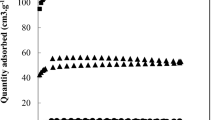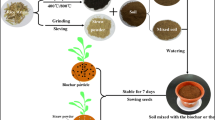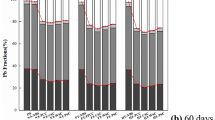Abstract
Purpose
After biochar is applied to soil as a sustainable soil amendment and a carbon (C) sequestration technique, its physicochemical properties change over time. However, few studies have reported on the changes of biochar properties over the aging process under field conditions. An understanding of such changes can help us to make full use of biochar as a sustainable soil amendment and C sequestration technique.
Materials and methods
We used apple tree branches as the raw material to produce biochar and studied the changes in the physicochemical properties of the biochar over a 5-year field experiment. Scanning electron microscopy (SEM), specific surface area (SSA) and micropore area, Fourier transform infrared (FTIR) spectroscopy, X-ray diffraction (XRD) spectroscopy, elemental analysis, and X-ray photoelectron spectroscopy (XPS) were performed.
Results and discussion
After 5 years of aging, the SSA of the biochar had increased by 23.91% relative to that of fresh biochar; however, the SSA initially decreased over the first 3 years and then increased over the next 2 years. The reasons for the initial decrease were the destruction and clogging of the existing pore structure, whereas new micropore formation was responsible for the subsequent increase, as verified by micropore area, SEM and XPS analyses. The C content of the biochar was stable over the 5 years, but the surface O content and quantity of oxygen-containing functional groups increased relative to those of fresh biochar, which impacts the adsorption capacity of the biochar.
Conclusions
Our findings illustrate that the SSA of the biochar varied with time during the aging process. The stability of the C illustrated the potential of biochar as a C sequestration technique. The increase in oxygen-containing functional groups of the biochar was responsible for the process of nutrient adsorption.





Similar content being viewed by others
References
Ahmad M, Lee SS, Dou X, Mohan D, Sung JK, Yang JE, Ok YS (2012) Effects of pyrolysis temperature on soybean stover- and peanut shell-derived biochar properties and TCE adsorption in water. Bioresour Technol 118(8):536–544
Azargohar R, Nanda S, Kozinski JA, Dalai AK, Sutarto R (2014) Effects of temperature on the physicochemical characteristics of fast pyrolysis bio-chars derived from Canadian waste biomass. Fuel 125(11):90–100
Basso AS, Miguez FE, Laird DA, Horton R, Westgate M (2013) Assessing potential of biochar for increasing water-holding capacity of sandy soils. GCB Bioenergy 5(2):132–143
Beesley L, Moreno-Jiménez E, Gomez-Eyles JL, Harris E, Robinson B, Sizmur T (2011) A review of biochars’ potential role in the remediation, revegetation and restoration of contaminated soils. Environ Pollut 159(12):3269–3282
Brewer CE, Chuang VJ, Masiello CA, Gonnermann H, Gao X, Dugan B, Driver LE, Panzacchi P, Zygourakis K, Davies CA (2014) New approaches to measuring biochar density and porosity. Biomass Bioenergy 66:176–185
Brunauer S, Emmett PH, Teller E (1938) Adsorption of gases in multimolecular layers. J Am Chem Soc 60:309–319
Chen B, Zhou D, Zhu L (2008) Transitional adsorption and partition of nonpolar and polar aromatic contaminants by biochars of pine needles with different pyrolytic temperatures. Environ Sci Technol 42(14):5137–5143
Cheng CH, Lehmann J, Thies JE, Burton SD, Engelhard MH (2006) Oxidation of black carbon by biotic and abiotic processes. Org Geochem 37:1477–1488
Cheng CH, Lehmann J, Engelhard MH (2008) Natural oxidation of black carbon in soils: changes in molecular form and surface charge along a climosequence. Geochim Cosmochim Ac 72(6):1598–1610
De Boer JH, Lippens BC, Linsen BG, Broekhoff JCP, Van Den Heuvel A, Osinga Th J (1966) The t-curve of multimolecular N2-adsorption. J Colloid Interface Sci 21:405–414
De la Rosa JM, Rosado M, Paneque M, Miller AZ, Knicker H (2018) Effects of aging under field conditions on biochar structure and composition: implications for biochar stability in soils. Sci Total Environ 613:969–976
Demirbas A (2004) Effects of temperature and particle size on bio-char yield from pyrolysis of agricultural residues. J Anal Appl Pyrol 72(2):243–248
Ding W, Dong X, Ime IM, Gao B, Ma LQ (2014) Pyrolytic temperatures impact lead sorption mechanisms by bagasse biochars. Chemosphere 105:68–74
Dong X, Li G, Lin Q, Zhao X (2017) Quantity and quality changes of biochar aged for 5 years in soil under field conditions. Catena 159:136–143
Ellerbrock RH, Gerke HH (2004) Characterizing organic matter of soil aggregate coatings and biopores by Fourier transform infrared spectroscopy. Eur J Soil Sci 55(2):219–228
Ghaffar A, Abbas G (2016) Adsorption of phthalic acid esters (PAEs) on chemically aged biochars. Green Process Synth 5(4):407–417
Ghaffar A, Ghosh S, Li F, Dong X, Zhang D, Wu M, Li H, Pan B (2015) Effect of biochar aging on surface characteristics and adsorption behavior of dialkyl phthalates. Environ Pollut 206:502–509
Guo Y, Bustin RM (1998) FTIR spectroscopy and reflectance of modern charcoals and fungal decayed woods: implications for studies of inertinite in coals. Int J Coal Geol 37(1–2):29–53
Guo Y, Tang W, Wu J, Huang J, Dai J (2014) Mechanism of Cu (II) adsorption inhibition on biochar by its aging process. J Environ Sci 26(10):2123–2130
Hale SE, Hanley K, Lehmann J, Zimmerman AR, Cornelissen G (2011) Effects of chemical, biological, and physical aging as well as soil addition on the sorption of pyrene to activated carbon and biochar. Environ Sci Technol 45:10445–10453
Heitkötter J, Marschner B (2015) Interactive effects of biochar ageing in soils related to feedstock, pyrolysis temperature, and historic charcoal production. Geoderma 245:56–64
Herath HMSK, Camps-Arbestain M, Hedley M (2013) Effect of biochar on soil physical properties in two contrasting soils: an Alfisol and an Andisol. Geoderma 209:188–197
Hockaday WC, Grannas AM, Kim SH, Hatcher PG (2007) The transformation and mobility of charcoal in a fire-impacted watershed. Geochim Cosmochim Acta 71(14):3432–3445
Huang Z, Hu LC, Zhou Q, Guo Y, Tang W, Dai J (2018) Effect of aging on surface chemistry of rice husk-derived biochar. Environ Prog Sustain 37(1):410–417
Huff MD, Lee JW (2016) Biochar-surface oxygenation with hydrogen peroxide. J Environ Manag 165:17–21
Kasin I, Ohlson M (2013) An experimental study of charcoal degradation in a boreal forest. Soil Biol Biochem 65:39–49
Khorram MS, Lin D, Zhang Q, Zheng Y, Fang H, Yu Y (2017) Effects of aging process on adsorption–desorption and bioavailability of fomesafen in an agricultural soil amended with rice hull biochar. J Environ Sci 56(6):180–191
Kumar A, Joseph S, Tsechansky L, Privat K, Schreiter IJ, Schüth C, Graber ER (2018) Biochar aging in contaminated soil promotes Zn immobilization due to changes in biochar surface structural and chemical properties. Sci Total Environ 626:953–961
Kupryianchyk D, Hale S, Zimmerman AR, Harvey O, Rutherford D, Abiven S, Knicker H, Schmidt H, Rumpel C, Cornelissen G (2016) Sorption of hydrophobic organic compounds to a diverse suite of carbonaceous materials with emphasis on biochar. Chemosphere 144:879–887
Kuzyakov Y, Bogomolova I, Glaser B (2014) Biochar stability in soil: decomposition during eight years and transformation as assessed by compound-specific 14C analysis. Soil Biol Biochem 70:229–236
Laird DA (2008) The charcoal vision: a win-win-win scenario for simultaneously producing bioenergy, permanently sequestering carbon, while improving soil and water quality. Agron J 100(1):178–181
Lawrinenko M, Laird DA, Johnson RL, Jing D (2016) Accelerated aging of biochars: impact on anion exchange capacity. Carbon 103:217–227
Lehmann J (2007a) Bio-energy in the black. Front Ecol Environ 5(7):381–387
Lehmann J (2007b) A handful of carbon. Nature 447:143–144
Lehmann J, Silva JPD, Steiner C, Nehls T, Zech W, Glaser B (2003) Nutrient availability and leaching in an archaeological Anthrosol and a Ferralsol of the Central Amazon basin: fertilizer, manure and charcoal amendments. Plant Soil 249(2):343–357
Lehmann J, Liang BQ, Solomon D, Lerotic M, Luizao F, Kinyangi J, Schafer T, Wirick S, Jacobsen C (2005) Near-edge X-ray absorption fine structure (NEXAFS) spectroscopy for mapping nano-scale distribution of organic carbon forms in soil: application to black carbon particles. Global Biogeochem Cycles 19:1–12
Lehmann J, Gaunt J, Rondon M (2006) Bio-char sequestration in terrestrial ecosystems - a review. Mitig Adapt Strateg Glob 11(2):403–427
Lehmann J, Skjemstad J, Sohi S, Carter J, Barson M, Falloon P, Coleman K, Woodbury P, Krull E (2008) Australian climate|[ndash]|carbon cycle feedback reduced by soil black carbon. Nat Geosci 1(12):832–835
Li F, Cao X, Zhao L, Wang J, Ding Z (2014) Effects of mineral additives on biochar formation: carbon retention, stability, and properties. Environ Sci Technol 48(19):11211–11217
Li H, Ye X, Geng Z, Zhou H, Guo X, Zhang Y, Zhao H, Wang G (2016) The influence of biochar type on long-term stabilization for Cd and Cu in contaminated paddy soils. J Hazard Mater 304:40–48
Liang B, Lehmann J, Solomon D, Kinyangi J, Grossman J, O'Neill B, Skjemstad JO, Thies J, Luizão FJ, Petersen J, Neves EG (2006) Black carbon increases cation exchange capacity in soils. Soil Sci Soc Am J 70(5):1719–1730
Liu Z, Demisie W, Zhang M (2013) Simulated degradation of biochar and its potential environmental implications. Environ Pollut 179:146–152
Liu Z, Chen X, Jing Y, Li Q, Zhang J, Huang Q (2014) Effects of biochar amendment on rapeseed and sweet potato yields and water stable aggregate in upland red soil. Catena 123:45–51
Martin SM, Kookana RS, Zwieten LV, Krull E (2012) Marked changes in herbicide sorption–desorption upon ageing of biochars in soil. J Hazard Mater 231:70–78
Mia S, Dijkstra FA, Singh B (2017a) Chapter one - long-term aging of biochar: a molecular understanding with agricultural and environmental implications. Adv Agron 141:1–51
Mia S, Dijkstra FA, Singh B (2017b) Aging induced changes in biochar’s functionality and adsorption behavior for phosphate and ammonium. Environ Sci Technol 51(15):8359–8367
Mukherjee A, Zimmerman AR, Hamdan R, Cooper WT (2014) Physicochemical changes in pyrogenic organic matter (biochar) after 15 months of field aging. Solid Earth 5(2):693–704
Mukome FND, Kilcoyne ALD, Parikh SJ (2014) Alteration of biochar carbon chemistry during soil incubations: SR-FTIR and NEXAFS investigation. Soil Sci Soc Am J 78:1632–1640
Obia A, Børresen T, Martinsen V, Cornelissen G, Mulder J (2017) Vertical and lateral transport of biochar in light-textured tropical soils. Soil Tillage Res 165:34–40
Pastorova I, Botto RE, Arisz PW, Boon JJ (1994) Cellulose char structure: a combined analytical Py-GC-MS, FTIR, and NMR study. Carbohydr Res 262(1):27–47
Pereira RC, Arbestain MC, Kaal J, Sueiro MV, Sevilla M, Hindmarsh J (2014) Detailed carbon chemistry in charcoals from pre-European Maori gardens of New Zealand as a tool for understanding biochar stability in soils. Eur J Soil Sci 65:83–95
Qian L, Chen M, Chen B (2015) Competitive adsorption of cadmium and aluminum onto fresh and oxidized biochars during aging processes. J Soils Sediments 15(5):1130–1138
Rechberger MV, Kloss S, Rennhofer H, Tintner J, Watzinger A, Soja G, Lichtenegger H, Zehetner F (2017) Changes in biochar physical and chemical properties: accelerated biochar aging in an acidic soil. Carbon 115:209–219
Ren X, Sun H, Wang F, Cao F (2016) The changes in biochar properties and sorption capacities after being cultured with wheat for 3 months. Chemosphere 144:2257–2263
Ren X, Wang F, Zhang P, Guo J, Sun H (2018a) Aging effect of minerals on biochar properties and sorption capacities for atrazine and phenanthrene. Chemosphere 206:51–58
Ren X, Yuan X, Sun H (2018b) Dynamic changes in atrazine and phenanthrene sorption behaviors during the aging of biochar in soils. Environ Sci Pollut Res 22:81–90
Rre A, Chapman SJ, Ahj R, Potts JM, LaggoundéFarge F, Gogo S, Comont L, Disnar J, Francez A (2008) FTIR spectroscopy can be used as a screening tool for organic matter quality in regenerating cutover peatlands. Soil Biol Biochem 40(2):515–527
Shi K, Xie Y, Qiu Y (2015) Natural oxidation of a temperature series of biochars: opposite effect on the sorption of aromatic cationic herbicides. Ecotoxicol Environ Saf 114:102–108
Sigmund G, Bucheli TD, Hilber I, Micić V, Kah M, Hofmann T (2017) Effect of ageing on the properties and polycyclic aromatic hydrocarbon composition of biochar. Environ Sci-Processes Impacts 19(5):768–774
Simkovic I, Dlapa P, Doerr SH, Mataix-Solera J, Sasinkova V (2008) Thermal destruction of soil water repellency and associated changes to soil organic matter as observed by FTIR spectroscopy. Catena 74:205–211
Singh BP, Cowie AL (2014) Long-term influence of biochar on native organic carbon mineralisation in a low-carbon clayey soil. Sci Rep 4(3):3687
Singh B, Fang Y, Cowie BCC, Thomsen L (2014) NEXAFS and XPS characterisation of carbon functional groups of fresh and aged biochars. Org Geochem 77(22):1–10
Singh B, Fang Y, Johnston CT (2016) A Fourier-transform infrared study of biochar aging in soils. Soil Sci Soc Am J 80(3):613–622
Sorrenti G, Masiello CA, Dugan B, Toselli M (2016) Biochar physico-chemical properties as affected by environmental exposure. Sci Total Environ 563:237–246
Trigo C, Spokas KA, Cox L, Koskinen WC (2014) Influence of soil biochar aging on sorption of the herbicides MCPA, Nicosulfuron, Terbuthylazine, Indaziflam, and Fluoroethyldiaminotriazine. J Agric Food Chem 62(45):10855–10860
Uchimiya M, Lima IM, Klasson KT, Chang SC, Wartelle LH, Rodgers JE (2010) Immobilization of heavy metal ions (CuII, CdII, NiII, and PbII) by broiler litter-derived biochars in water and soil. J Agric Food Chem 58(9):5538–5544
Uchimiya M, Bannon DI, Wartelle LH (2012) Retention of heavy metals by carboxyl functional groups of biochars in small arms range soil. J Agric Food Chem 60:1798–1809
Wang H, Feng M, Zhou F, Huang X, Tsang DCW, Zhang W (2017) Effects of atmospheric ageing under different temperatures on surface properties of sludge-derived biochar and metal/metalloid stabilization. Chemosphere 184:176–184
Wang T, Stewart CE, Sun C, Wang Y, Zheng J (2018) Effects of biochar addition on evaporation in the five typical Loess Plateau soils. Catena 162:29–39
Xu Y, Lou Z, Yi P, Chen J, Ma X, Wang Y, Li M, Chen W, Liu Q, Zhou J, Zhang J, Qian G (2014) Improving abiotic reducing ability of hydrothermal biochar by low temperature oxidation under air. Bioresour Technol 172:212–218
Yang H, Xu R, Xue X, Li F, Li G (2008) Hybrid surfactant-templated mesoporous silica formed in ethanol and its application for heavy metal removal. J Hazard Mater 152(2):690–698
Yao FX, Arbestain MC, Virgel S, Blanco F, Arostegui J, Maciá-Agulló JA, Macías F (2010) Simulated geochemical weathering of a mineral ash-rich biochar in a modified Soxhlet reactor. Chemosphere 80(7):724–732
Zama EF, Reid BJ, Sun GX, Yuan HY, Li XM, Zhu YG (2018) Silicon (Si) biochar for the mitigation of arsenic (As) bioaccumulation in spinach (Spinacia oleracean) and improvement in the plant growth. J Clean Prod 189:386–395
Zhang J, Lü F, Zhang H, Shao L, Chen D, He P (2015) Multiscale visualization of the structural and characteristic changes of sewage sludge biochar oriented towards potential agronomic and environmental implication. Sci Rep 5:9406
Zhang X, Sarmah AK, Bolan NS, He L, Lin X, Che L, Tang C, Wang H (2016) Effect of aging process on adsorption of diethyl phthalate in soils amended with bamboo biochar. Chemosphere 142:28–34
Zhelezova A, Cederlund H, Stenström J (2017) Effect of biochar amendment and ageing on adsorption and degradation of two herbicides. Water Air Soil Pollut 228(6):216
Zielke U, Huttinger KJ, Hoffman WP (1996) Surface-oxidized carbon fibers: I. surface structure and chemistry. Carbon 34(8):983–998
Acknowledgments
We thank Professor Hui Shi at the Xi’an University of Architecture and Technology for his assistance with the sample analyses.
Funding
This study received funding from the National Key Research and Development Plan of China (2016YFC0501702, 2017YFC0504504), the National Natural Science Foundation of China (41571225), and the STS project of the Chinese Academy of Sciences (KFJ-STS-ZDTP-012).
Author information
Authors and Affiliations
Corresponding author
Additional information
Responsible editor: Yong Sik Ok
Publisher’s note
Springer Nature remains neutral with regard to jurisdictional claims in published maps and institutional affiliations.
Rights and permissions
About this article
Cite this article
Tan, L., Sun, C., Wang, Y. et al. Changes in biochar properties in typical loess soil under a 5-year field experiment. J Soils Sediments 20, 340–351 (2020). https://doi.org/10.1007/s11368-019-02398-0
Received:
Accepted:
Published:
Issue Date:
DOI: https://doi.org/10.1007/s11368-019-02398-0




